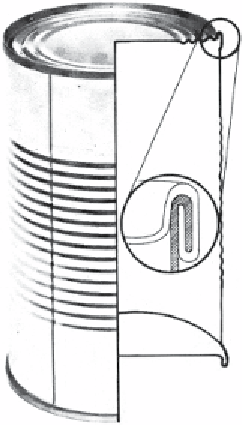Agriculture Reference
In-Depth Information
not, however, withstand the high internal pressure
developed during processing and must therefore be
sterilised in media (water or steam and air) capable of
providing an external pressure sufficient to balance the
internal one.
For the thermal processing of the open or sanitary
can, flame sterilisation, for example, the Tarax flame
steriliser developed in Australia, combined with rotation
of the can, is now used for certain products. This system
has the advantage of being relatively cheap and is capable
of providing very efficient heat transfer in those prod-
ucts with some liquid.
Future forms of thermal processing may involve the
use of microwave energy, hydrostatic sterilisers using
high-efficiency steam and fluidised-bed systems.
Section
through
seam
Traditional canning methodology
As a food container, the metal can - first developed by
Nicolas Appert in France in 1795 - has certain virtues
possessed by no other type of container for heat-pro-
cessed foods (Fig. 4.2). It has a high conductivity, which
is of importance during processing; it cannot easily be
broken; and being opaque, any possible deleterious
effects of light on the foodstuff are avoided.
There are currently three main methods of can manu-
facture, the most common being the traditional
three-
piece food can
. Constant research and development are in
operation to improve techniques and designs. Over the
years, the amount of metal in cans has been reduced, and
soldering, which involved the use of lead, has long been
discarded. The process of can manufacture begins with
sheets of tinplated steel (Fig. 4.3) (1). Some of these may
be coated with lacquer and dried in ovens for 15-20
minutes. Lacquers are used to prevent contact between
food and tinplate and vary in type according to the class
of food to be canned - acid foods like fruit, high-protein
foods such as meat, etc. The lacquer-coated sheets are
cut into lengths and widths for specific can sizes (2, 3).
Individual strips are then rolled into cylinders (4), and
the two edges of the cylinder drawn together with an
overlap which is
electrically welded
(5). At this stage, the
cylinders are given a further coat of lacquer on the seams
and dried in an oven. A lip is next formed on each end of
the cylinder (6). Separate ends (lids and bases) (7) are
made in a different area, and the rims of these ends are
curled, and a sealing compound is injected into the curl
(8). The base is next joined to the cylinder body, the seal-
ing compound forming an airtight seal. The cans, with
their separate lids, are now ready for use by the food
processor.
The
two-piece drawn and wall-ironed can
(DWI) con-
sists of two pieces of tinplate, the body and base being
formed from one piece of metal and the lid from another.
Figure 4.2
Modern food can showing section through seam
(by courtesy of Metal Box Ltd).
The body and base are shaped from a thick piece of tin-
plate which is drawn up, ironed and ridged for strength
and then given a coat of lacquer.
The
drawn and redrawn
(DRD) can is manufactured
from two pieces of tinplate, the body being made from a
disc-shaped piece, lacquered on both sides and drawn up
to form a shallow cup and then redrawn a second and
third time to make a deep cup.
Although the term
tin can
is applied to currently used
containers, this is something of a misnomer as they are
constructed of mild steel with a thin coating of pure tin
representing about 1.5% of the can's weight. Coating of
the steel plate is necessary to prevent corrosion, and in
some foodstuffs, such as fish or fruit, a fish or fruit
lacquer is used. Unsightly staining of the surface of
certain foodstuff, known as
sulphiding
, may also occur
and is avoided by use of a phenolic meat lacquer or a
sulphur-resistant lacquer. An alternative method of
avoiding sulphiding is now being extensively employed
for meat packs and consists of chemical treatment of the
inside of the can to form an invisible film, the solution
used being a strong alkali bath containing phosphates
and chromates.
Treatment of food to be canned
The food to be canned must be clean and of good qual-
ity; the use of any material showing obvious signs of
spoilage will result in deterioration in quality of the
product. Many foods, particularly fruits and vegetables,
are scalded or blanched before treatment, to cleanse the
product, to produce shrinkage which permits adequate

